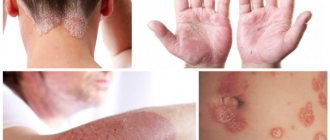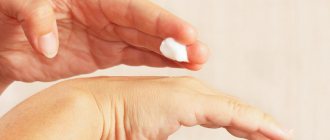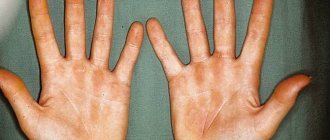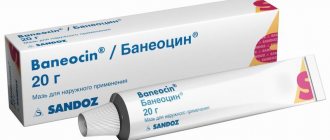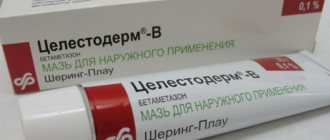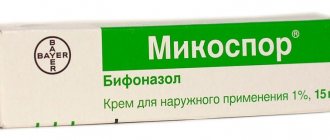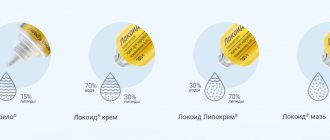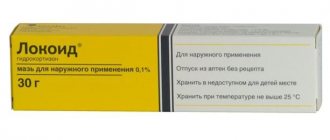Composition and release form
Oflomelid contains three components:
- ofloxacin 10 mg;
- methyluracil 40 mg;
- lidocaine hydrochloride 30 mg.
Oflomelide is available as a white or off-white ointment. In one tube - 30 g. For medical institutions, the drug is also supplied in polymer jars of 200-2000 g.
The cost of one tube of ointment is 150-200 rubles. Since the drug contains an antibiotic, it is sold in pharmacies only with a doctor's prescription.
Indications for use
What Oflomelid helps with is clear from its composition. The ointment is prescribed where it is necessary to remove the inflammatory process, suppress the development of a bacterial infection, relieve pain and stimulate tissue healing. According to the official instructions for use, Oflomelid is used in the following situations:
- infected wounds in the postoperative period and after injury;
- infected burns of II-IV degree;
- bedsores;
- trophic ulcers;
- wounds after opening boils, carbuncles, festering neoplasms, etc.
Oflomelide is used in surgery to treat various purulent diseases of the skin, soft tissues and bones. He copes with complications due to systemic diseases - diabetic foot, varicose veins with the formation of ulcers. It is used for burns and frostbite due to secondary infection of tissues.
Oflomelid ointment: what it helps with, detailed instructions for use, composition, analogues and reviews
According to the instructions for use of Oflomelid, the ointment has a wide range of contraindications. The drug is prohibited for the treatment of children, pregnant and breastfeeding women.
Description of the drug
The integrity of the skin is compromised as a result of injury or exacerbation of chronic pathologies. Pathogenic bacteria penetrate onto wound surfaces, provoking an intensification of pathological processes. For treatment it is necessary to use antibacterial, anti-inflammatory, anti-exudative agents.
To avoid pharmacological stress on the body, doctors use combination drugs. One of the most effective is Oflomelid. The drug contains active ingredients that have a diverse therapeutic effect.
The instructions for use indicate what Oflomelid ointment helps with:
- methyluracil accelerates wound healing and promotes rapid crust formation;
- lidocaine reduces the severity of pain, skin itching, burning;
- the antibacterial component ofloxacin eliminates the cause of suppuration - infectious pathogens.
The drug is a white thick mass that does not have any specific odor. It penetrates into inflammatory areas, providing a therapeutic effect a few minutes after application.
And the auxiliary ingredients form a durable thin film on the surface of the wound. It protects damaged tissues from the penetration of infectious agents - pathogenic fungi and bacteria.
Pharmacological group and action
Oflomelide is included in the clinical and pharmacological group of combined drugs for the treatment of infectious skin lesions. The ointment is characterized by an anti-inflammatory effect. Its components are not able to directly influence the production of prostaglandins.
Relief of inflammation occurs as a result of inhibition of pathogenic bacteria. The drug is used for burns of moderate and high (2-4) severity, ulcers, purulent boils. It is not advisable to use the product for wound therapy in the absence of an infectious component.
One of the components is a broad-spectrum antibiotic. It is active against almost all pathogenic bacteria:
- gram-negative - salmonella, klebsiella, shigella;
- gram-positive - Staphylococcus aureus, streptococci.
The antibacterial agent is capable of inhibiting mycoplasmas, chlamydia, and some types of E. coli. Ofloxacin interferes with the production of proteins necessary for the construction of bacterial cells. Their integrity is compromised, which causes the death of pathogenic microorganisms.
https://www.youtube.com/watch?v=_D3k30qJKHs
The second active ingredient, methyluracil, stimulates tissue regeneration by accelerating metabolism. Under its influence, young connective tissues are formed faster, tightening wound surfaces. Methyluracil stimulates the biosynthesis of proteins necessary for granulation of the skin and mucous membranes.
Oflomelid's analgesic properties are provided by lidocaine, a powerful anesthetic. It blocks channels through which sodium ions enter cells. As a result, there is no generation of pain impulses in sensitive nerve endings. Their transmission to the central nervous system also becomes impossible.
Release form and composition
Oflomelide is available in only one dosage form - as an ointment. Manufacturers package it in 30 g quantities in sealed aluminum tubes. The secondary packaging is a cardboard box with instructions for use inside.
The drug is also available in polymer (1-2 kg) and glass (0.2-0.4 kg) jars. They are intended for hospitals where trauma patients are treated.
The composition of Oflomelid is represented by the following active and auxiliary ingredients:
- methyluracil;
- lidocaine hydrochloride;
- ofloxacin;
- macrogol;
- propylene glycol;
- methylparaben;
- propylparaben.
The absence of fat in the composition promotes rapid absorption of active components into the deepest epidermal layers. Propylene glycol ensures the pH level of the product is as close as possible to the acidity of the skin. In this way, manufacturers have improved its absorption by the skin and reduced the likelihood of local side effects.
The ointment is intended to be stored in a dark place at room temperature. Shelf life: 24 months. After the tube has been leaked, Oflomelid should be used for 2-3 weeks.
Instructions for use
The main indications for the use of Oflomelid are infectious and inflammatory skin pathologies. Before prescribing the ointment, the species of microorganisms is determined during biochemical studies.
The drug is included in treatment regimens when sensitivity to ofloxacin is detected. It is used in the treatment of severe injuries, such as deep wounds.
Before applying the ointment, bedsores or ulcers are cleaned of necrotic tissue.
Indications and contraindications
Oflomelide is one of the most commonly used drugs during the rehabilitation period. The ointment is used to treat the skin after excision of necrotic areas of the skin. It is applied after opening boils, atheromas, accompanied by purulent abscesses. In what cases is the use of Oflomelid indicated:
- the drug is used for burns that have become infected with pathogenic bacteria. Its effectiveness does not depend on the etiology of injury. Active ingredients stimulate the regeneration of skin damaged by thermal, radiation or chemical exposure;
- the product is used in postoperative treatment of purulent inflammation of apocrine sweat glands and lipomas;
- the ointment is prescribed to patients with long-term non-healing bedsores and trophic ulcers.
The high effectiveness of Oflomelid is ensured by the presence of ingredients with powerful pharmacological actions. But this also determines a large number of contraindications. The external agent is not prescribed to patients with hypersensitivity to active or auxiliary components. In childhood and adolescence, the use of the combined drug is contraindicated.
Directions for use and doses
Single, daily dosages, duration of the therapeutic course and method of treatment are determined by the doctor. Oflomelide should not be used more than once a day. This frequency of use is due to the high concentration of basic substances.
More frequent treatment of wounds will provoke the penetration of ingredients into the bloodstream and the development of adverse reactions. It is not recommended to carry out treatment longer than 2 weeks. If there is no improvement within this time, you should consult a doctor.
It will complement the therapeutic regimen or replace the ointment with more effective analogues.
Apply the drug in a thin layer, otherwise the risk of accumulation of purulent exudate increases. It is distributed directly onto previously cleaned wound surfaces. A sterile napkin is applied to the damaged skin.
After this, the application is secured with adhesive tape. For deep wounds, it is advisable to use gauze turunda. A sufficient amount of ointment is applied to them to completely saturate them.
After treating the wound, turunda is carefully introduced into it.
For hemorrhoids, the use of Oflomelid is strictly prohibited. There is no such indication in the instructions for use.
Side effects and special instructions
With prolonged use of the product, allergic reactions may develop. Clinically, they are manifested by swelling and redness of the skin, the formation of small rashes. Treatment with Oflomelid is not carried out during pregnancy. The external agent contains components that can have a teratogenic effect. The ointment is not prescribed not only to pregnant women, but also to lactating women.
The active ingredients do not interact with other drugs. But to achieve maximum clinical effect, it is necessary to maintain an interval between applications of 2-3 hours. In traumatology, the combination of Oflomelid with antiseptic solutions and regeneration stimulants is practiced. If wounds are bleeding, it is recommended to treat them with hydrogen peroxide.
Analogs
The current analogues of Oflomelid are Levomekol, Levosin, Vishnevsky's liniment, Argosulfan, Bepanten Plus.
Reviews
I could not use Oflomelid due to hypersensitivity to propylene glycol. But there are no structural analogues of the ointment in pharmacies. Ofloxacin, methyluracil, and lidocaine are not contained together in any drug. The doctor prescribed Levosin, which has a similar effect. After the stroke, my mother did not get up for a long time and a wound appeared on her buttock. The doctor recommended using Oflomelid to heal bedsores. After 2-3 days the skin recovered.
Source: https://mydoctorok.ru/mazi/oflomelid-maz-instruktsiya-po-primeneniyu.html
How Oflomelid works
The effect of the drug is associated with the components included in its composition:
- Ofloxacin is an antibiotic from the fluoroquinolone group. Effective against a large number of bacteria that cause purulent lesions of the skin, bones and soft tissues. Blocks DNA gyrase, an enzyme in bacterial cells. It has a bactericidal effect - it not only inhibits reproduction, but also destroys pathogenic microorganisms. Works against staphylococci, streptococci, enterobacteria, some anaerobic and intracellular bacteria (including chlamydia and mycoplasma).
- Methyluracil is a drug that enhances tissue regeneration. It triggers anabolic processes - stimulates metabolism, accelerates the formation of new cells and the formation of protective epithelium. It differs from many similar drugs in that it is able to work in the presence of pus and necrotic tissue - exactly where ofloxacin acts.
- Lidocaine is a local anesthetic. It acts on the peripheral nervous system - it prevents the formation of impulses and prevents them from being carried into the brain. Relieves pain accompanying purulent wounds, bedsores and burns. When used externally, it also dilates blood vessels.
Oflomelid meets the requirements for drugs for the treatment of infected wounds:
- It has a wide spectrum of action - it is destructive against the main pathogens of the purulent process.
- Does not lose properties in the presence of pus.
- Prevents drying out of the wound surface.
- Enhances tissue regeneration.
- Relieves pain.
- Penetrates tissue to a sufficient depth to cope with infection.
- It is characterized by low toxicity and does not have local irritating properties.
- It is well tolerated and rarely causes serious adverse reactions.
There are no data on the pharmacokinetics of the drug. It is not known exactly whether the components of the ointment penetrate the systemic bloodstream and affect the condition of internal organs. Practical observations show that the drug does not have a systemic effect.
pharmachologic effect
A medicine with antimicrobial, local analgesic, anti-inflammatory and regenerating activities, which are provided by the components included in Oflomelid.
Ofloxacin belongs to the group of fluoroquinolones and has an antimicrobial effect , which is manifested against most microorganisms. Due to the blockade of the DNA gyrase enzyme in the microbial cell, a bactericidal effect . The drug affects staphylococci, anaerobes, chlamydia, Escherichia coli, legionella, mycoplasma, pseudomonas, streptococci, Proteus and other microorganisms.
Methiuracil is able to stimulate regenerative processes in tissues. Anabolic activity is manifested . The active component is capable of accelerating epithelization , granulation tissue maturation and growth, and accelerating cellular regenerative processes in case of wound damage.
Lidocaine is known for its local analgesic effect, which is achieved by blocking sodium channels and preventing impulse generation in the endings of sensory neurons. The active substance prevents the transmission of pain impulses along nerve fibers. Local irritating effects do not occur when applied externally. The active substance is capable of expanding the lumen of blood vessels.
The hyperosmolar (hydrophilic), water-soluble ointment base is a mixture of polyethylene glycols (polyethylene oxides), the molecular weight of which is 400-1500 units. The base provides a moisture-absorbing, dehydrating effect when applied to fabrics. Compared to a sodium chloride solution (10%), the hyperosmotic effect of the ointment base is 20 times stronger.
Evaluation of the effectiveness of the drug
Oflomelid is produced in Russia and has no analogues abroad. Therefore, there are no serious studies on this drug in the English-language literature. The PubMed database presents works on individual components of the ointment and shows their effectiveness - but what is important for us is how these substances work in combination. Therefore, it is worth turning to Russian-language sources and finding references to the drug there.
A review of the literature shows that Oflomelid ointment has successfully passed clinical trials. The studies were carried out in 2008 in Moscow in the department of purulent surgery of the Institute of Surgery named after. A.V. Vishnevsky and at the Burn Center of the Research Institute of Emergency Medicine named after. N.V. Sklifosovsky. The authors made the following conclusions:
- Oflomelid ointment is effective against the main pathogens of skin and soft tissue infections. This allows the drug to be used as a first aid remedy without waiting for the results of a bacteriological study.
- Oflomelid copes where other ointments do not work. It acts against highly resistant strains of Acinetobacter spp., methicillin-resistant strains of S.epidermalis, etc., including pathogens of hospital infections. Rare medicines fight these microorganisms, and Oflomelid ointment is one of them.
- The drug effectively copes with the consequences of diabetic foot syndrome. In diabetes mellitus, chronic wound defects of the skin and soft tissues often develop. They grow bacteria that are resistant to most antibiotics used. Oflomelid ointment successfully suppresses the growth of these microorganisms and avoids limb amputation.
On a note
Clinical trials have shown that Oflomelid ointment works better than many similar products. It outperforms Levomekol, an old antibacterial drug, especially in the treatment of burn wounds.
Application diagram
The ointment is for topical use only. The drug is applied once a day to the affected area. The dosage depends on the area of influence, but should not exceed 100 g per day.
The duration of therapy varies individually, but is usually 1-2 weeks. The positive effect of treatment is noticeable after 2-3 days. The wound surface is cleaned, necrotic tissue and pus are melted, and epithelization processes begin. The pain subsides within the first day of using the ointment. If the condition does not improve, you need to consult a doctor and change the drug.
Important! Oflomelid is a strong remedy. You should not use the ointment for minor scratches and minor damage to the skin - where it is enough to apply an antiseptic or do without medications at all. An antibacterial agent is prescribed if there is a pronounced purulent process.
The ointment is applied directly to the wound or burn surface, but only after standard treatment. First you need to remove non-viable tissue and pus, then use the drug. Next, apply a sterile dressing to the wound and change it as needed.
For large wound surfaces, use tampons soaked in ointment. Tampons are loosely filled into the wound cavity, inserted into the fistula tracts and removed as they become saturated with pus.
Analogs
Oflomelid ointment is traditionally compared with Levomekol. These are not analogues - the drugs differ in composition. They have only one component in common - methyluracil, which stimulates tissue regeneration. There are more differences between ointments:
- Levomekol contains the antimicrobial agent chloramphenicol, Oflomelid contains the antibiotic ofloxacin. The antibiotic has a wider spectrum of action and is more effective against purulent wounds.
- Oflomelid contains lidocaine, so the drug relieves pain. Levomekol does not have such an effect, and additional analgesics must be used.
The scope of application of Oflomelid ointment is wider, but so far this drug cannot completely replace Levomekol. The final choice of medication depends on the sensitivity of the microorganisms identified in the wound.
Which is better: Oflomelid or Levomekol
Oflomelid and Levomekol.
Photo: generic-forum.ru The drugs are not analogues of each other. Oflomelid is a combination drug that has antimicrobial, anti-inflammatory, local anesthetic, and regenerating effects. Active ingredients: Ofloxacin, Methyluracil and Lidocaine. Levomekol is a combination drug with two active ingredients: Chloramphenicol and Methyluracil. Indicated for purulent wounds (including those infected with mixed microflora) in the first (purulent-necrotic) phase of the wound process. In pediatrics, it can be used in children from 1 year of age. Oflomelid is indicated from 18 years of age. Levomekol is available without a doctor's prescription. The drug Oflomelid is prescribed by a doctor and is available in pharmacies with a prescription.
Both drugs are produced in Russia. Oflomelid is more expensive than Levomekol. The cost of Levomekol per package is from 98 rubles.
conclusions
Briefly about the important:
- Oflomelid is an ointment against infected wounds, bedsores and burns. Destroys pathogenic microorganisms, relieves pain and accelerates tissue healing.
- Oflomelid is used primarily in surgery for purulent infections and is not intended for self-medication. This is not an ointment from a home medicine cabinet, but a potent remedy. requiring medical supervision.
- Oflomelid works predominantly locally and does not cause significant adverse reactions.
- The ointment is prohibited for use during pregnancy, lactation and in children under 18 years of age - its safety has not been proven.
- The effectiveness of the drug has been confirmed by clinical trials, but only on the Russian pharmaceutical market.
Side effects and contraindications
Oflomelid ointment is an antibacterial drug that belongs to the category of potent drugs that have a number of contraindications. Their list includes:
- age under 18 years;
- period of pregnancy and lactation;
- hypersensitivity to the drug or its individual components.
In order to check the tolerability of the drug, before using it, apply a small amount of ointment to the elbow. In the absence of allergic manifestations: rashes, redness and itching, treatment can begin.
Before using Oflomelid on your own, it is recommended to consult a dermatologist. Despite the availability and effectiveness of this remedy for burns, in case of minor injuries with mild pain, its use is not advisable. While maintaining the integrity of the skin, gentler medications should be used.
Side effects include allergic reactions in case of individual intolerance to the main or auxiliary components of the drug. It is prohibited to use anti-burn ointment that has expired or has become damaged due to improper storage.
The shelf life of Oflomelid is two years from the date of release. It is recommended to store the ointment in a dark place at a temperature of 15 to 20°C.
Reviews
Anastasia, Syktyvkar
The ointment was recommended by my parents; the doctor prescribed it to my father after a leg injury. I can’t say that I get injured often, but sometimes I have to undergo treatment. I tried Oflomelid ointment - the wound from the knife healed literally within a day. There was pain, but with the ointment it was much easier to bear.
Lyudmila, Tikhoretsk Ointment helped my husband cope with a wound after an unsuccessful treatment with an angle grinder. He didn’t go to the emergency room - he said we’ll treat ourselves. From the very first use, the pain subsided - apparently due to lidocaine. After three days of use, the shallow wounds almost completely dried out and healed. The largest wound was covered with a thick crust. There was no suppuration of the wound. After a week, only a large scab remained, the rest gradually healed.
Vladimir, Zhukovsky Ointment saves from boils - it relieves pain well and quickly copes with the wound at the site of the opened abscess. Removes redness of the skin around the boil. It helps quickly - literally in a few days there is no trace of boils left.

